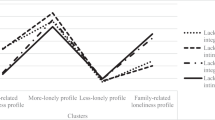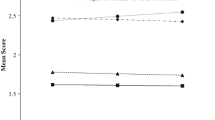Abstract
Childhood loneliness is characterised by children’s perceived dissatisfaction with aspects of their social relationships. This 8-year prospective study investigates whether loneliness in childhood predicts depressive symptoms in adolescence, controlling for early childhood indicators of emotional problems and a sociometric measure of peer social preference. 296 children were tested in the infant years of primary school (T1 5 years of age), in the upper primary school (T2 9 years of age) and in secondary school (T3 13 years of age). At T1, children completed the loneliness assessment and sociometric interview. Their teachers completed externalisation and internalisation rating scales for each child. At T2, children completed a loneliness assessment, a measure of depressive symptoms, and the sociometric interview. At T3, children completed the depressive symptom assessment. An SEM analysis showed that depressive symptoms in early adolescence (age 13) were predicted by reports of depressive symptoms at age 8, which were themselves predicted by internalisation in the infant school (5 years). The interactive effect of loneliness at 5 and 9, indicative of prolonged loneliness in childhood, also predicted depressive symptoms at age 13. Parent and peer-related loneliness at age 5 and 9, peer acceptance variables, and duration of parent loneliness did not predict depression. Our results suggest that enduring peer-related loneliness during childhood constitutes an interpersonal stressor that predisposes children to adolescent depressive symptoms. Possible mediators are discussed.


Similar content being viewed by others
Notes
We use criteria of a comparative fit index (CFI) above 0.95, and the root mean square error of approximation (RMSEA) <0.10 to indicate adequate model fit as suggested elsewhere [62].
One potential issue in studies of this nature is that an atypical group of high scorers on both loneliness and depression variables may drive the findings of the analysis. This is a particular issue with the interaction variable, which emphasises the effect of consistently high loneliness scores. To investigate whether a very small number of children were lonely at both time points, but were also very depressed at Time 3, we observed the scattergrams comparing T1 loneliness, T2 loneliness, the interaction term, and the predicted values obtained from a multivariate predictive equation composed of these variables, with T3 depression scores. We found no evidence of correlations being overly influenced by high scorers.
References
Abramson LY, Alloy LB, Hankin BL, Haeffel GJ, MacCoon DG, Gill BE (2002) Cognitive-vulnerability-stress models of depression in a self-regulatory and psychological context. In: Gotlib IH, Hammen EL (eds) Handbook of depression. Guilford, New York
Adams J, White M (2006) Removing the health domain from the index of multiple deprivation—effect on measured inequalities in census measure of health. J Public Health 28:379–383
Aiken LS, West SG (1991) Multiple regression: testing and interpreting interactions. Sage, Newbury Park
Birmaher B, Ryan SW, Williamson D, Brent D, Kaufman J, Dahl R, Perel J, Nelson B (1996) Childhood and adolescent depression: a review of the past ten years. J Am Acad Child Adolesc Psychiatry 35:1427–1439
Boivin M, Hymel S, Bukowski WM (1995) The roles of social withdrawal, peer rejection, and victimisation by peers in predicting loneliness and depressed mood in childhood. Dev Psychopathol 7:765–785
Borelli JL, Prinstein MJ (2006) Reciprocal, longitudinal associations among adolescents’ negative feedback-seeking, depressive symptoms, and peer relations. J Abnorm Child Psychol 34:159–169
Boyce WT, Ellis BJ (2005) Biological sensitivity to context: an evolutionary-developmental theory of the origins ad functions of stress reactivity. Dev Psychopathol 17:271–301
Brendgen M, Wanner B, Morin AJS, Vitaro F (2005) Relations with parents and with peers, temperament, and trajectories of depressed mood during early adolescence. J Abnorm Child Psychol 33:579–594
Buhs ES, Ladd GW (2001) Peer rejection as antecedent of young children’s school adjustment: an examination of mediating processes. Dev Psychol 37:550–560
Cacioppo JT, Hughes ME, Waite LJ, Hawkley LC, Thisted RA (2006) Loneliness as a specific risk factor for depressive symptoms: cross sectional and longitudinal analyses. Psychol Ageing 21:140–151
Cacioppo JT, Patrick W (2008) Loneliness: human nature and the need for social connection. W.W. Norton and Company, London
Carstensen LL, Isaacowitz DM, Charles ST (1999) Taking time seriously: a theory of socioemotional selectivity. Am Psychol 54:165–181
Cohen J, Cohen P, West SG, Aiken LS (2002) Applied multiple regression/correlation analysis for the behavioural sciences. Lawrence Erlbaum Associates, London
Coie JD, Dodge KA (1983) Continuity of children’s social status: a five-year longitudinal study. Merrill-Palmer Q 29:261–282
Connors C (1969) A teacher rating scale for use in drug studies with children. Am J Psychiatry 126:884–888
Cowen E, Gesten EL, Wilson AB (1979) The primary mental health project (PMHP): evaluation of current program effectiveness. Am J Community Psychol 7:293–303
Crocker AD, Hakim-Larson J (1997) Predictors of pre-adolescent depression and suicidal ideation. Can J Behav Sci 29:76–82
Dumas JE, Neese DE, Prinz RJ, Blechman EA (1996) Short term stability of aggression, peer rejection, and depressive symptoms in middle childhood. J Abnorm Child Psychol 24:105–119
Eberhart NK, Hammen CL (2006) Interpersonal predictors of onset of depression during the transition to adulthood. Pers Relationsh 13:195–206
Ferguson DM, Horwood LJ, Ridder EM, Beautrais AL (2005) Subthreshold depression in adolescence and mental health outcomes in adulthood. Arch Gen Psychiatry 62:66–72
Ferguson DM, Woodward LJ (2002) Mental health, educational, and social role outcomes of adolescents with depression. Arch Gen Psychiatry 59:225–231
Flora J, Segrin C (2000) Relationship development in dating couples: implications for relational satisfaction and loneliness. J Soc Pers Relationsh 17:811–825
Fombonne E, Wostear G, Cooper V, Harrington R, Rutter M (2001) The Maudsley long-term follow-up of child and adolescent depression. Br J Psychiatry 179:210–217
Gerson A, Perlman D (1979) Loneliness and expressive communication. J Abnorm Psychol 88:258–261
Goossens L, Beyers W (2002) Comparing measures of childhood loneliness: internal consistency and confirmatory factor analysis. J Clin Child Psychol 31:252–262
Hagerty BM, Williams RA (1999) The effects of sense of belonging, social support, conflict, and loneliness on depression. Nurs Res 48:215–219
Harter S, Nowakowski M (1987) Manual for the dimensions of depression profile for children and adolescents. University of Denver, Denver
Harter S, Marold DB (1994) Psychosocial risk factors contributing to adolescent suicidal ideation. New Dir Child Dev 71–91
Harter S, Marold D, Whitesell NR (1992) A model of psychosocial risk factors leading to suicidal ideation in young adolescents. Dev Psychopathol 4:167–188
Hawkley LC, Cacioppo JT (2003) Loneliness and pathways to disease. Brain Behav Immun 17:S98–S105
Heikkinen R, Kauppinen M (2004) Depressive symptoms in late life: a 10 year follow-up. Arch Gerontol Geriatr 38:239–250
Henin A, Biederman J, Mick E, Sachs GS, Hirshfield-Becker DR, Siegel RS, McMurrich S, Grandin L, Nierenberg AA (2005) Psychopathology in the offspring of parents with bipolar disorders: a controlled study. Biol Psychiatry 58:554–561
Hymel S, Tarulli D, Hayden-Thomson L, Terrell-Deutsch B (1999) Loneliness through the eyes of children. In: Rotenberg KJ, Hymel S (eds) Loneliness in childhood and adolescence. Cambridge University Press, Cambridge
Kerr DCR, Preuss LJ, King CA (2006) Suicidal adolescents’ social support from family and peers: gender-specific associations with psychopathology. J Abnorm Child Psychol 34:103–114
Kistner J, Balthazor M, Risi S, Burton C (1999) Predicting dysphoria in adolescence from actual and perceived peer acceptance in childhood. J Clin Child Psychol 28:94–104
Koenig LJ, Abrams RF (1999) Adolescent loneliness and adjustment: a focus on gender differences. In: Rotenberg KJ, Hymel S (eds) Loneliness in childhood and adolescence. Cambridge University Press, Cambridge
Koenig LJ, Isaacs AM, Schwartz JAJ (1994) Sex differences in adolescent depression and loneliness: why are boys lonelier if girls are more depressed? J Res Pers 28:27–43
Kovacs M (1985) The children’s depression, inventory (CDI). Psychopharmacol Bull 21:995–998
Kupersmidt JB, Patterson CJ (1991) Childhood peer rejection, aggression, withdrawal, and perceived competence as predictors of self-reported behaviour problems in preadolescence. J Abnorm Child Psychol 19:427–449
Ladd GW (2006) Peer rejection, aggressive or withdrawn behaviour, and psychological maladjustment from ages 5–12: an examination of four predictive models. Child Dev 77:822–846
Lau S, Chan DWK, Lau PS (1999) Facets of loneliness and depression among Chinese children and adolescents. J Soc Psychol 139:713–729
Leve LD, Kim HK, Pears KC (2005) Childhood temperament and family environments as predictors of internalising and externalising trajectories from ages 5 to 17. J Abnorm Child Psychol 33:505–520
Lorion RP, Cowen EL (1978) Referral to school mental health project: a screening note. Am J Community Psychol 6:247–251
Luby JL, Heffelfinger A, Koenig-McNaught AL, Brown K, Spitznagel E (2004) The preschool feelings checklist: a brief and sensitive screening measure for depression in young children. J Am Acad Child Adolesc Psychiatry 43:708–717
Marcoen A, Goossens L, Caes P (1987) Loneliness in pre through late adolescence: exploring the contribution of a multidimensional approach. J Youth Adolesc 16:561–577
Martin JM, Cole DA, Clausen C, Logan J, Wilson Strosher HL (2003) Moderators of the relation between popularity and depressive symptoms in children: processing strength and friendship value. J Abnorm Child Psychol 31:471–483
Murry L, Woolgar M, Cooper P, Hipwell A (2001) Cognitive vulnerability to depression in 5-year old children and depressed mothers. J Child Psychol Psychiatry 42:891–899
Nangle DW, Erdley CA, Newman JE, Mason CA, Carpenter EM (2003) Popularity, friendship quantity, and friendship quality: interactive influences on children’s loneliness and depression. J Clin Child Adolesc Psychol 32:546–555
Nolen-Hoesksema S, Ahrens C (2002) Age differences and similarities in the correlates of depressive symptoms. Psychol Ageing 17:116–124
Panak WF, Garber J (1992) Role of aggression, rejection, and attributions in the prediction of depression in children. Dev Psychopathol 4:145–165
Pederson S, Vitaro F, Barker ED, Borge AIH (2007) The timing of middle-childhood peer rejection and friendship: linking earl behaviour to early adolescent adjustment. Child Dev 78:1037–1051
Peplau LA, Perlman D (1982) Perspectives on loneliness. In: Peplau LA, Perlman D (eds) Loneliness: a sourcebook of current theory, research and therapy. Wiley, New York
Prinstein MJ, Aikins JW (2004) Cognitive moderators of the longitudinal association between peer rejection and adolescent depressive symptoms. J Abnorm Child Psychol 32:147–158
Qualter P, Munn P (2002) The separateness of emotional and social isolation in childhood. J Child Psychol Psychiatry 43:233–244
Qualter P, Munn P (2005) The friendships and play partners of lonely children. J Soc Pers Relationsh 22:379–397
Qualter P (2003) Loneliness in children and adolescents: what do schools and teachers need to know and how can they help? Pastoral Care Educ 21:10–19
Renshaw PD, Brown PJ (1993) Loneliness in middle childhood: concurrent and longitudinal predictors. Child Dev 64:1271–1284
Rotenberg KJ (1999) Childhood loneliness: an introduction. In: Rotenberg KJ, Hymel S (eds) Loneliness in childhood and adolescence. Cambridge University Press, Cambridge
Rudolph KD, Hammen C, Burge D, Lindberg N, Herzberg D, Daley SE (2000) Toward an interpersonal life-stress model of depression: the developmental context of stress generation. Dev Psychopathol 12:215–234
Rutter M, Kim-Cohen J, Maughan B (2006) Continuities and discontinuities in psychopathology between childhood and adult life. J Child Psychol Psychiatry 47:276–295
Sund AM, Larsson B, Wichstrom L (2003) Psychosocial correlates of depressive symptoms among 12–14 year old Norwegian adolescents. J Child Psychol Psychiatry 44:588–597
Tabachnick BG, Fidell LS (2001) Using multivariate statistics, 4th edn. Allyn & Bacon, Boston
Valery JH, O’Connor P, Jennings S (1997) The nature and amount of support college-age adolescents request and receive from parents. Adolescence 32:323–337
Weissberg RP, Cowen EL, Lotyczewski BS, Gesten EL (1983) The Primary Mental Health Project: seven consecutive years of program outcome research. J Consult Clin Psychol 51:100–107
Young JE (1982) Loneliness, depression, and cognitive therapy: theory and application. In: Peplau LA, Perlman D (eds) Loneliness: a sourcebook of current theory, research, and therapy. Wiley, London
Acknowledgments
Thanks are extended to Anna Kearney and Peter Fleming for assisting with data collection and input. Thanks also to Lancashire County Council for their help in tracking the children and forwarding consent forms to parents. Also, many thanks to the teachers and children who took part in the study. In addition, we would like to thank the two anonymous reviewers for their comments and recommendations.
Author information
Authors and Affiliations
Corresponding author
Rights and permissions
About this article
Cite this article
Qualter, P., Brown, S.L., Munn, P. et al. Childhood loneliness as a predictor of adolescent depressive symptoms: an 8-year longitudinal study. Eur Child Adolesc Psychiatry 19, 493–501 (2010). https://doi.org/10.1007/s00787-009-0059-y
Received:
Accepted:
Published:
Issue Date:
DOI: https://doi.org/10.1007/s00787-009-0059-y




